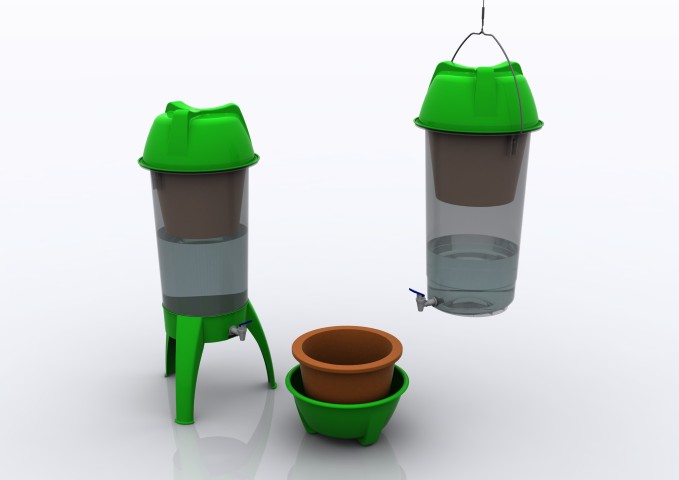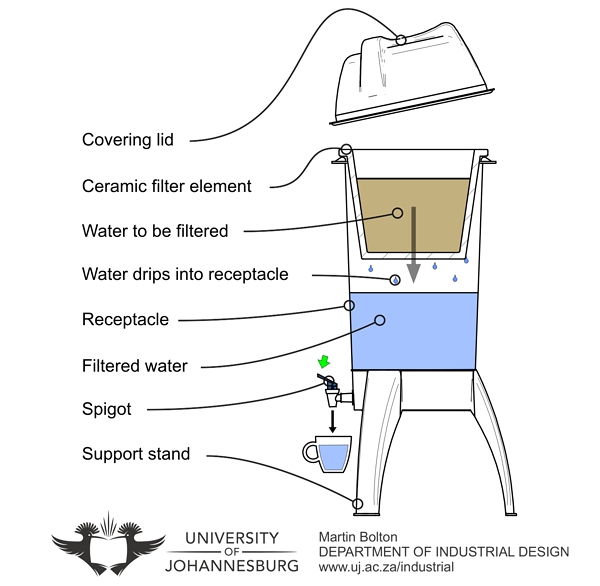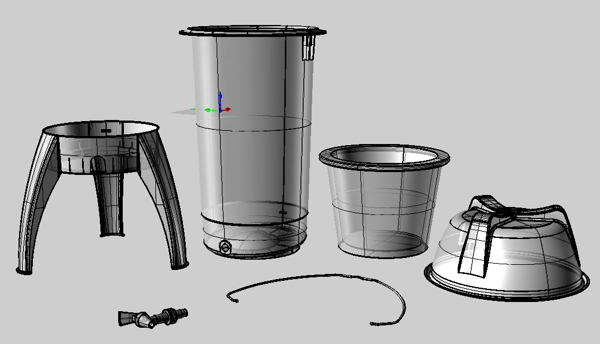Vhembe Water Filter
Design and development of an improved low-cost ceramic water filter based on the existing Potpaz home water treatment device for use within rural households of the Vhembe region of South Africa.
This design was the outcome of a Masters in Industrial Design, from the University of Johannesburgs Department of Industrial Design. The Vhembe Water filter was designed by Martin Bolton, who lectures at the University of Johannesburg. This WIKI was created as an open-source showcase of Design Development, Design Sketches as well as all relevant Computer Generated Models which can be used for design refinement/ prototyping, tooling, mass production etc. It is suggested that the MTech dissertation be read to allow for the understanding of how and why this product was developed. Furthermore, all field research, data gathering, data analysis and development of design requirements will be evident. The entire MTech Dissertation is viewable on the University Website. A journal article was submitted and published in the Image and Text Journal, you are able to read the journal article here. This journal article is titled THE VHEMBE FILTER: A PRODUCT FOR RURAL SOUTH AFRICA, and provides an overview of the research approach and developmental steps taken leading to the final design outcome.
CAD Rendering of Vhembe Water Filter
This project aimed to develop the Potpaz ceramic water filter into an improved filter design optimally suited to South African rural conditions, to provide potable water rather than contaminated water to households. Communities that do not have access to in-house treated water often end up with a contaminated water supply, as the water to be consumed is usually sourced from communal water collection points and stored in containers. There is evidence that the water consumed at point-of-use in rural areas is not always of a potable quality due to possible contamination between collection and consumption. The existing Potpaz home water treatment device has been scientifically proven to return contaminated water to a potable state. A limited number of existing Potpaz filters were imported to South Africa for use in a project that studied the effect of household point-of-use treatment on the health of the consumer. It was not at all certain whether the households would use these devices effectively because this filter was not part of their everyday water system. Part of investigating whether or not they would effectively use this filter was the inclusion of industrial design within the filter assessment section of a larger research project conducted in the Vhembe region to understand the requirements of the user. Industrial design concerns itself with the requirements of the user, as well as knowledge regarding product design, development and manufacturing. Households that took part in the point-of-use project used the Potpaz home water treatment device for more than two months and were approached to provide feedback regarding its use. From the feedback, it became evident that there were aspects of the Potpaz design that needed modification towards an improved water filter more suited for its intended use in rural households. An Action Research influenced methodology and User Centred Design approach informed the collection of original data and feedback on areas of improvement. This, together with visits to local shops and community potters, provided sufficient background to understand the needs and preferences of the intended rural users regarding the use of the device. This informed the design process and increased the chances of developing a readily accepted, more suitable product to the intended users and the domestic environment in which they live. To achieve this, this project focused on the following aspects regarding Potpaz filters: placement, use and design aspects of usability and ergonomics. Development of the improved filter design culminated in rapid prototyping of a scale model and the fabrication of a full-size working model allowing for physical interface to evaluate the success of the design solution.
Design Requirement Diagram
The following is a diagram which was compiled from the analysed data. This served as a starting point in the creation of a detailed, diverse sketch development portfolio. Reading through the MTech Dissertation will assist with understanding the relevance of the design decisions Get the dissertation here.
CAD Renderings of final design The following is a collection of rendered images of the final design outcome.
An operational schematic of the Vhembe Filter design
CAD FILES The following is a collection of the final CAD files of the Vhembe Filter. Please note that these were modelled at scale 1:1 in mm, and not in inches. The initial files are all Rhino4 version files. I am not sure which is the most usable, distributable file-type.
File:Vhembe Filter Assembly Variations. Floor standing and hanging.3dm
File:Vhembe Filter Disassembled. All components.3dm
File:Vhembe Water Filter Assembled floor standing.3dm
File:Vhembe Water Filter Receptacle with standard spigot.3dm
File:Vhembe Water Filter Support Stand.3dm
File:Vhembe Water Filter Covering Lid.3dm
File:Vhembe Water Filter Element Potters For Peace standard component.3dm
Sketch Portfolio The following collection of images are scanned images from the Design Development Portfolio. These involve diversive sketch exploration, slowly leading to the final concept outcome.
FABRICATED PROTOTYPE A full size test prototype of the final design was fabricated from ABS Plastic sheet, and incorporated several standard components (Potters For Peace filer element and a standard plastic Spigot). The wire hanging handle was bent from approximately 6mm steel rod.




































































